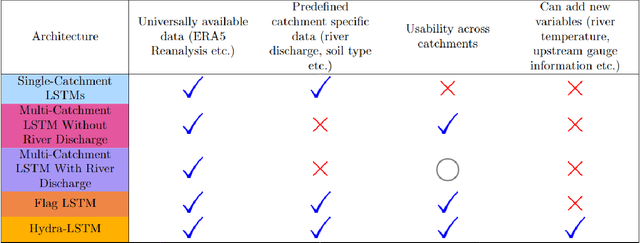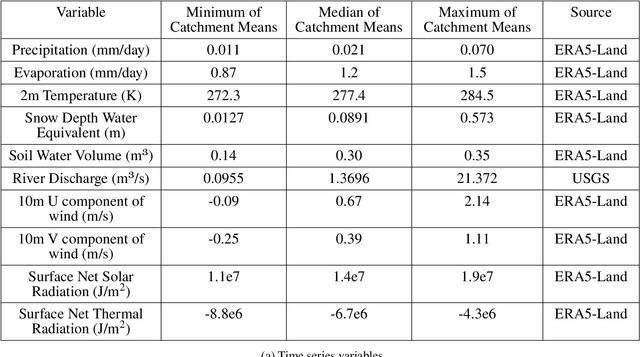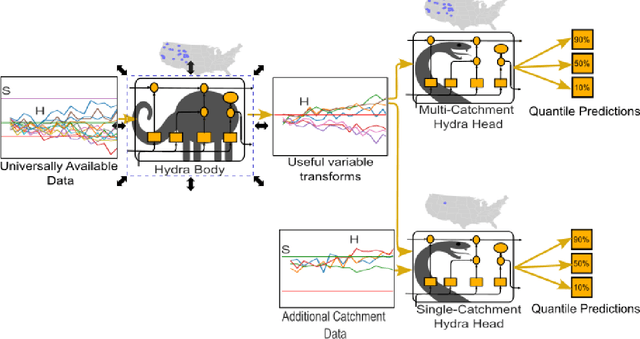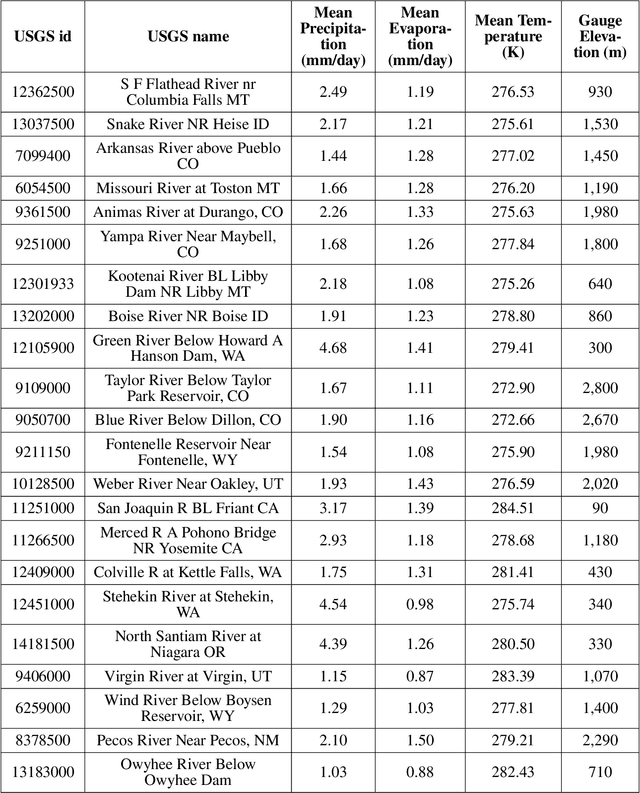Christel Prudhomme
Hydra-LSTM: A semi-shared Machine Learning architecture for prediction across Watersheds
Oct 21, 2024



Abstract:Long Short Term Memory networks (LSTMs) are used to build single models that predict river discharge across many catchments. These models offer greater accuracy than models trained on each catchment independently if using the same data. However, the same data is rarely available for all catchments. This prevents the use of variables available only in some catchments, such as historic river discharge or upstream discharge. The only existing method that allows for optional variables requires all variables to be considered in the initial training of the model, limiting its transferability to new catchments. To address this limitation, we develop the Hydra-LSTM. The Hydra-LSTM processes variables used across all catchments and variables used in only some catchments separately to allow general training and use of catchment-specific data in individual catchments. The bulk of the model can be shared across catchments, maintaining the benefits of multi-catchment models to generalise, while also benefitting from the advantages of using bespoke data. We apply this methodology to 1 day-ahead river discharge prediction in the Western US, as next-day river discharge prediction is the first step towards prediction across longer time scales. We obtain state-of-the-art performance, generating more accurate median and quantile predictions than Multi-Catchment and Single-Catchment LSTMs while allowing local forecasters to easily introduce and remove variables from their prediction set. We test the ability of the Hydra-LSTM to incorporate catchment-specific data by introducing historical river discharge as a catchment-specific input, outperforming state-of-the-art models without needing to train an entirely new model.
AI Increases Global Access to Reliable Flood Forecasts
Aug 10, 2023



Abstract:Floods are one of the most common and impactful natural disasters, with a disproportionate impact in developing countries that often lack dense streamflow monitoring networks. Accurate and timely warnings are critical for mitigating flood risks, but accurate hydrological simulation models typically must be calibrated to long data records in each watershed where they are applied. We developed an Artificial Intelligence (AI) model to predict extreme hydrological events at timescales up to 7 days in advance. This model significantly outperforms current state of the art global hydrology models (the Copernicus Emergency Management Service Global Flood Awareness System) across all continents, lead times, and return periods. AI is especially effective at forecasting in ungauged basins, which is important because only a few percent of the world's watersheds have stream gauges, with a disproportionate number of ungauged basins in developing countries that are especially vulnerable to the human impacts of flooding. We produce forecasts of extreme events in South America and Africa that achieve reliability approaching the current state of the art in Europe and North America, and we achieve reliability at between 4 and 6-day lead times that are similar to current state of the art nowcasts (0-day lead time). Additionally, we achieve accuracies over 10-year return period events that are similar to current accuracies over 2-year return period events, meaning that AI can provide warnings earlier and over larger and more impactful events. The model that we develop in this paper has been incorporated into an operational early warning system that produces publicly available (free and open) forecasts in real time in over 80 countries. This work using AI and open data highlights a need for increasing the availability of hydrological data to continue to improve global access to reliable flood warnings.
 Add to Chrome
Add to Chrome Add to Firefox
Add to Firefox Add to Edge
Add to Edge